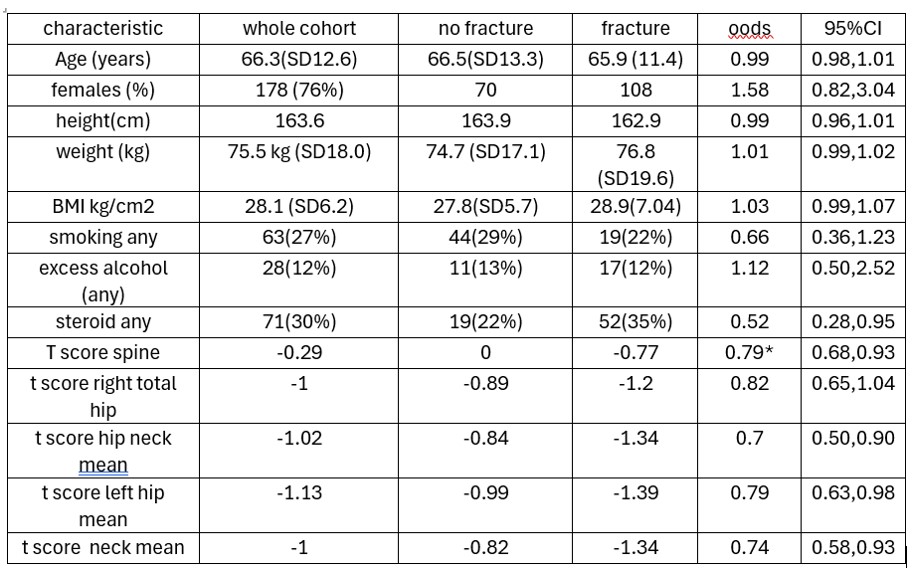Session Information
Date: Sunday, November 17, 2024
Title: SpA Including PsA – Diagnosis, Manifestations, & Outcomes Poster II
Session Type: Poster Session B
Session Time: 10:30AM-12:30PM
Background/Purpose: Data on bone health in patients with psoriatic arthritis (PsA) are scarce with low numbers being described in the literature , a meta-analysis published in 2020 estimated that patients with psoriatic disease had a higher OR of developing bone fractures (adjusted OR: 1.09; 95% CI: 1.06 to 1.12 (1), but this was based on modest number of small studies with less than a 100 participants. per study . Rheumatoid arthritis is well known be a predictor of poor bone health and further fragility fractures and is included in the FRAX(tm) fracture prediction tool . We set out to look at the associations between traditional risk factors, including FRAX™ factors with PsA in an observational cohort referred for Bone mineral density (BMD) estimation. We also looked at the pattern of fragility fracture in this cohort.
Methods: Patients referred for BMD estimation using DEXA between April 2006 and February 2024 to a scanner in the North west of England were used. Patients demographics as well as other risk factors for fracture were recorded as well as the presence of any fragility fracture, Bone density was estimated in both femoral necks as well as the lumbar spine. The cohort was divided according to the presence of a prevalent fragility fracture and compared, initially using chi squared test for categorical variables , students T test for continuous variables and a subsequent logistic model was fitted using fracture as a dependant variable to determine if the expected predictors would be associated with prevalent fracture.
Results: Results: 233 patients were referred to the DEXA scanner in the study period. Mean age was 66.2 years (SD 12.6).178 (78.9%) were female, median BMI was 27.7 (IQR 23.5, 31.3). 86 (36.9%) had a prevalent fracture. The differences and odds ratios are shown in table 1 below. None of the traditional risk factors were associated with fracture in this cohort and while bone density loss was associated with prevalent fracture , this occurred at a lower BMD than would be expected with a T score in the osteopenic range with a T score averaging -1.3 in the femoral neck and -1.1 in the spine. The vast majority of the fractures were not in the femur with only 9 (10%) being femoral. 32(37%) were vertebral fractures.
Conclusion: In the largest cohort who have been studied to date, fracture in PsA has not been linked with RX(tm) predictors, Fractures tended to associated with lower bone density. Femoral fractures seemed to less prevalent in the cohort with more vertebral fractures found. This should be taken into consideration when assessing bone health in patients with psoriatic arthritis. Strengths include the large numbers assessed for bone health , limitations include the risk of referral bias , however finding prevalent fractures in osteopenic individuals should raise awareness of the risk in patients with psoriatic disease.
Ref. 1.Chen et al J Clin Med. 2020 Nov; 9(11): 371
To cite this abstract in AMA style:
Amin H, Bukhari M. Predictors and Patterns of Fragility Fracture in an Observational Cohort of Patients with Psoriatic Arthritis [abstract]. Arthritis Rheumatol. 2024; 76 (suppl 9). https://acrabstracts.org/abstract/predictors-and-patterns-of-fragility-fracture-in-an-observational-cohort-of-patients-with-psoriatic-arthritis/. Accessed .« Back to ACR Convergence 2024
ACR Meeting Abstracts - https://acrabstracts.org/abstract/predictors-and-patterns-of-fragility-fracture-in-an-observational-cohort-of-patients-with-psoriatic-arthritis/

